The future confrontation of equal rivals forces the West to change the concept of non-combat vehicles
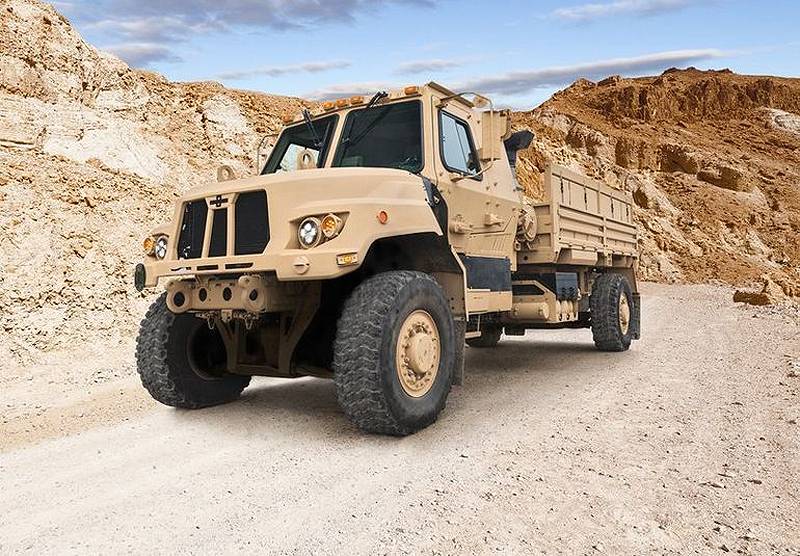
The demand for trucks of the Family of Medium Tactical Vehicle (medium-capacity military vehicles) has only been growing recently.
In recent years, special attention has been paid to non-combat vehicles, especially material and engineering supplies. Industry experts note that in response to changing threats, the need for greater flexibility, maneuverability and autonomy is growing.
According to Mike Ivey of Oshkosh Defense, the term “non-combat vehicles” is increasingly becoming redundant, since on the modern battlefield, weapons of destruction, developing in their diversity, put all platforms at risk. “I'm not sure what this phrase means now,” he said. “From the experience gained by the US military and our allies in Iraq and Afghanistan, it is clear that any machine on the battlefield today is a fighting machine.” Ivey added that although the machine may not have an 120-mm cannon or an 30-mm cannon, however, in this non-linear battle space, those sitting in it can be at the epicenter of the battle at any time. "Our holistic understanding of the classification of cars, frankly, has changed significantly over the past decade."
Evolving needs
Oshkosh is a major supplier of heavy, medium and light tactical vehicles and other platforms for the US military and its allies. The company manufactures a full range of logistics vehicles, for example, PLS (Palletized Load System) multifunctional transport platform and NEMTT A4 off-road heavy duty truck. It also manufactures a JLTV (Joint Light Tactical Vehicle) tactical armored vehicle for the US Army, an MRAP category vehicle for the Army, and a Marine Corps and a number of other platforms.
As explained by Pat Williams, program manager for the army and the Marine Corps at Oshkosh Defense, the original design of the previous versions of heavy and medium tactical vehicles did not provide enhanced protection, but later they were additionally armored to improve crew safety.
“Approaches to modern vehicles are different. The JLTV armored car, for example, was built from scratch for future needs, meeting or exceeding all software requirements for protection, mobility, payload and transportability, taking into account the possibility for growth and adaptability in the event of a change in the nature of the battlefield or challenges faced by ground forces - he continued. “We always think about how soldiers can do their difficult work — often in difficult terrain, against a very aggressive and well-informed enemy — and return home alive.”
The performance characteristics of JLTV-like machines have been improved over time, and “it would be nice to improve the capabilities of other types of support machines,” said Williams. In this regard, he highlighted the FMTV family of medium-duty vehicles (Family of Medium Tactical Vehicles), which the company has been manufacturing for more than five years under contract with the American army. In June, Oshkosh received four additional orders from the army for these vehicles, designed to provide combat missions, logistics and humanitarian assistance. Williams stated that a total of more than 28000 machines will be manufactured under the main contract.
Requirements for FMTV evolved over time, the army wanted to raise the level of booking a car. "The army decided that a machine with increased payload, improved vitality, smoothness and increased mobility was needed." However, in order to meet all these requirements, it is necessary to simultaneously solve a number of rather complex problems.
“When you add additional armor or increase the carrying capacity, driving performance and mobility are impaired,” explained Williams. “So you have to balance it all.” To make a number of compromises, eventually getting a car with higher performance that the military needs. ”
Role models
According to Bill Sheehy, AMPV Program Manager, the need to continuously upgrade machines to meet evolving needs and threats also influences BAE Systems' approach to the AMPV (Armored Multi-Purpose Vehicle) multi-purpose armored vehicle. BAE, under a contract with the US Army, should manufacture five platform options: general purpose; mortar conveyor; commander; and two medical models. Sheehy noted that the design of AMPV has the opportunity to grow by 20% in order to have the potential for future technological development.
Of the two AMPV medical options being developed, one is designed to evacuate the wounded, and the other to provide medical care. The AMPV as a whole is a more maneuverable machine than the M113 BTR, which is being replaced, thanks to an improved power unit and tracks and many other improvements.
As Sheehy noted, it is especially beneficial from a medical point of view. For example, in the case of a large number of injured, the AMPV medical evacuation machine will be able to reach the scene of the accident and then transport the injured to the medical aid vehicle - “literally a surgical operating room on the tracks” - which itself can move to a position closer to the line of battle, “that is, the surgeons will in their hands seriously wounded soldiers faster and will be able to stabilize their condition. "
Sheehy called AMPV digital architecture a major step forward. From a medical point of view, this means that information can be transferred to the hospital more quickly and therefore "they are better able to prepare to receive the wounded." Many of the design features implemented in modern civil ambulances were transferred to AMPV. All these innovations are largely related to the improvement of the power unit, since "in addition to traditional consumers, you now need a lot of power to power this entire digital architecture."
In addition, BAE is in the early stages of developing an AMPV engineering machine variant, although it has not been contracted. According to Sheehy, he will mainly be engaged in making passages in minefields and marking them. BAE and other companies are currently working with the US Army Engineering School to determine the future needs of the army in this area. The army tested the contracted AMPV variants at Fort Hood in August 2018. These vehicles took part in demonstration field maneuvers along with units equipped with the M113 BTR. The army plans to decide on the production of AMPV machines at the end of this year, after which the company VAE will begin production of the installation batch.
The equipment manufactured by Pearson Engineering, which previously could only be seen on specialized machines, is currently being installed on a wider range of platforms.
Achieving a balance
According to Richard Beatson from Pearson Engineering, manufacturers of mine neutralization equipment and improvised explosive devices (IEDs) are also constantly faced with the need to implement technological changes.
“Everything we do should be determined by the customer’s requirements, and each of his requirements is determined by the threat,” he noted. - As soon as we provide the end user with the means to combat the threat, our opponents immediately leave with a new threat. Therefore, we must constantly develop and refine our equipment to stay ahead of the evolving threat. ”
Bitson said that in times of tight defense budgets, there is an increased demand for versatility. Pearson’s customers increasingly want their equipment, such as plows and dumps, to be installed on several different platforms, from the main combat tanks to cars of the middle category by weight. The transition from counterinsurgency operations back to operations with almost equal or equal rivals greatly stimulates this process.
“According to our estimates, all armored vehicles will need to have engineering capabilities, at least partially. If they find themselves in a minefield, for example, they can quickly get out of there themselves, ”he explained.
Beatson said that military Western countries and NATO have a growing interest in Pearson's proposals, while there is a clear tendency to return to "high-intensity hostilities." The military of many countries of the world spent the last 10-15 years on conducting counter-insurgency operations, and this until recently determined various procurement priorities.
Beatson noted that Pearson Engineering pays special attention to weight and size and energy-consuming characteristics, and therefore conducts extensive research and development aimed at reducing weight while maintaining performance and protection. For example, progress in the field of construction materials means that modern systems can use less metal compared to previous versions. “With new technologies, we can become much easier while maintaining the capabilities of the systems. We spend a lot of time and energy on the so-called smart design. ”
However, he added that “there is a balance between losing weight and saving the mass, because these are different physical quantities. If you hit a mine, a big heavy piece of metal between you and the explosion could well save your life. ”
Pearson works closely with its customers, either directly with the military or with manufacturers of equipment, in order to minimize efforts to find the right balance, Beatson explained. - First of all, we carefully study the car, even in detail, in order to determine the centers of gravity, the effect of mass on the transmission, suspension, etc. This is very important and therefore we optimize our equipment for installation on a specific machine. ”
The company works in four main areas related to the combat systems: mine clearance, neutralization of IEDs, earthworks, and bridges. Although the first two are the dominant part of the company's business, Pearson has recently seen an increased demand for bridge building systems that allow large numbers of personnel to overcome small obstacles. "Our rapid reaction forces also need fast-acting bridges."
Beatson noted the British Tugo project, which BAE Systems is working on. Its goal is to upgrade or replace the bridge system so that it can cope with heavy loads and remain in operation until the 2040 year.
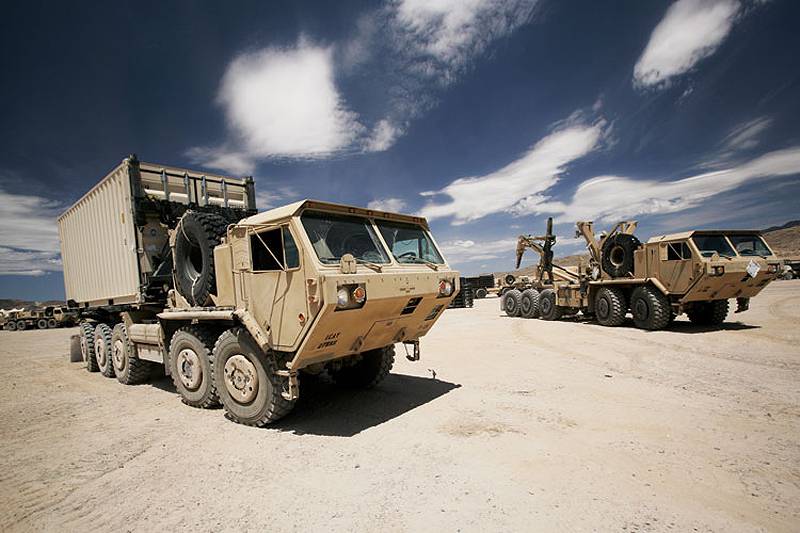
PLS Platform is one of the Oshkosh Defense procurement solutions.
Forward to autonomy
Due to the fact that engineering vehicles, logistics vehicles and other non-combat platforms on the modern battlefield are increasingly faced with a variety of threats and in order to reduce losses among personnel, special attention is paid to the development of unmanaged systems.
For example, Oshkosh Defense has developed Tagtamax technology, which integrates computers, electronic controls and distributed sensory systems for controlling ground-based robotized vehicles. It can be integrated into crew vehicles, actually turning them into robotic vehicles.
“A large number of losses in Iraq were due to IEDs. It was undermined by many supply vehicles that carried cargo. That is, the idea of a crew car is to have fewer people in trucks in transport convoys, ”said Williams. He drew particular attention to the work that Oshkosh company, as part of the Expedient Leader Follower army program, conducts with the Research and Development Armored Center, integrating scalable autonomous technology into the multipurpose transport platform PLS.
In June of this year, the company received a contract for 49 million dollars for the supply of ten PLS machines for this project, which must pass state tests before another 60 machines will be purchased in 2019 year. The operational tests of these 60 machines will begin in the 2020 year, “and then the army will decide on the future of the program whether to accept them for supply in greater numbers”.
Beatson said that in the field of engineering machines, unmanaged or autonomous versions can be compared to "guiding stars." Pearson is currently working with a number of customers on testing and demonstrating traditional crew vehicles that have been finalized and can now work without crew. “In the coming years we will hear one word more and more often -“ autonomy ”, that is, the exclusion of a soldier from the control loop. I believe that this technology will stimulate everything else, especially in the field of fighting mines and IEDs. ”
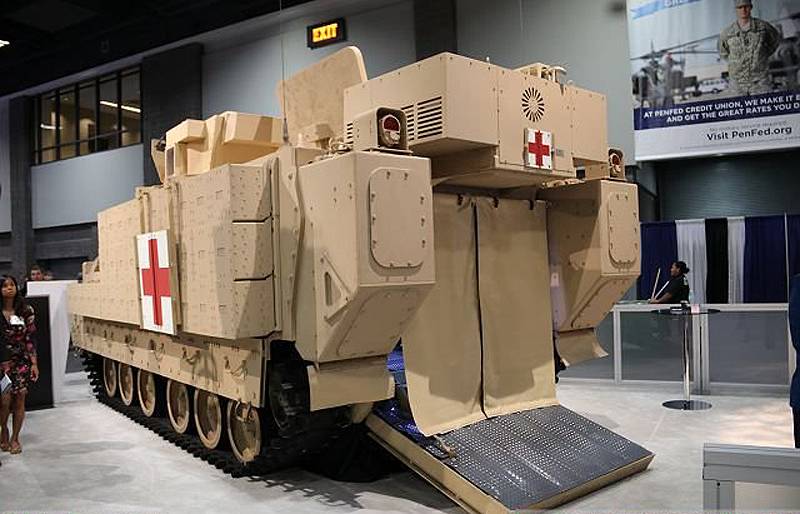
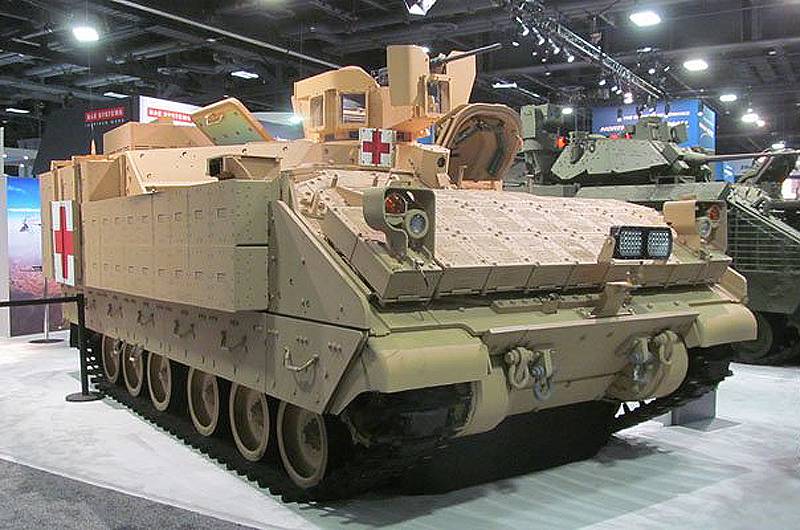
The AMPV Medical Assistance Machine is one of five options that BAE Systems is developing for the US Army.
Innovative flexibility
According to Ivey, the changing nature of the battlefield also forces us to pay more attention to the protection of security platforms against cyber threats. “Customers want machines that are resistant to such threats and into which systems can be integrated to protect against such threats,” he said, adding that the latest Oshkosh platforms were designed with this in mind. "We are thinking now not only about resilience regarding the threats of the real world, but also about resilience to the threats of cyberspace."
In such a dynamic space, machine design flexibility is the key to success. Recently, there has been a growing demand for equipping JLTV and similar vehicles with lethal weapons, ranging from DUMV to air defense systems and machine guns. "We see an increasing demand for weapons systems installed on Oshkosh vehicles, which give them offensive and defensive capabilities."
Williams agreed with this, drawing attention to the work of Raytheon on installing an FMN laser laser weapon system 100 kW, developed by the US Army High Energy Laser Tactical Vehicle Demonstration program.
Beatson also pointed out the importance of functional flexibility, noting that “in the West there are only one or two armies that can operate different machines for individual tasks in size and budget. “A more general approach is to use available funds in accordance with a specific task.” Depending on the operational task, different sets of equipment are installed on the machine each time, for example, a mine plow or a skating rink. This equipment can be integrated with a specialized machine, although it can also be installed on MBT or another platform, which is usually not used for clearing mines and IEDs.
Armies are becoming “incredibly inventive when it comes to how to conduct military operations with limited resources ... As suppliers, we need to be a little smarter about how best to offer them innovation,” added Beatson. In his opinion, the market for engineering machines is to be expanded in the coming years. “As soon as you cope with the Threat“ A ”, your opponents come with the Threat“ B ”, as a result there is a constant battle. It is important and correct that the military of all countries, without exception, is very concerned about the survival of their soldiers. ”
In the future, according to Williams, autonomy will continue to develop. Also, special attention will be paid to the integration of more advanced weapons into platforms that are not technically designed for combat roles. “We are moving to fight with almost equal threats and therefore they should be able to do what is possible and should not have been done in the counterinsurgency scenario.”
The basis of everything is constant adaptation to changes in threats, what impact they can have on machines of all categories. “Our opponents are smart and as our capabilities develop to protect their threats, they also develop,” said Williams. “Therefore, we should try to offer customers protection against new threats, even sometimes ahead of the curve - this is exactly what we should do.”
Materials used:
www.shephardmedia.com
oshkoshdefense.com
www.baesystems.com
www.pearson-eng.com
www.wikipedia.org
en.wikipedia.org
www.pinterest.ru
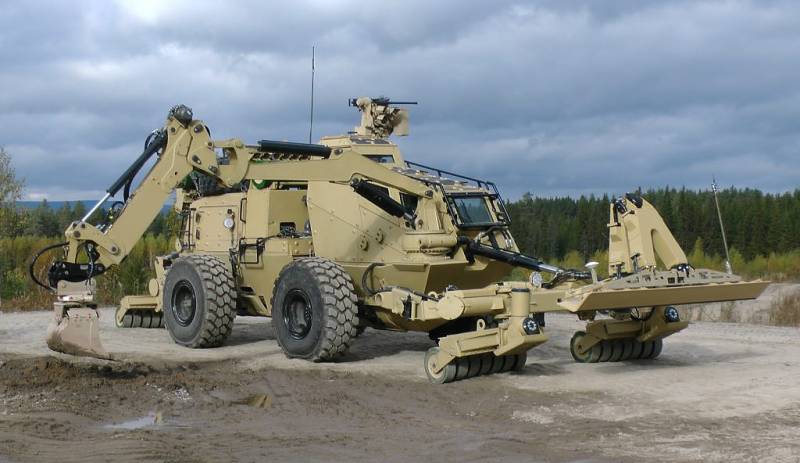
Information